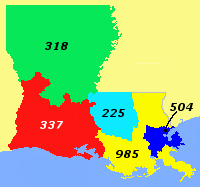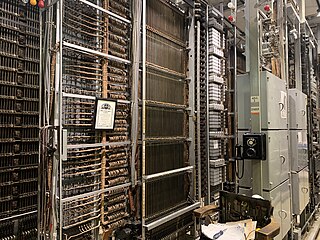
The North American Numbering Plan (NANP) is a telephone numbering plan for twenty-five regions in twenty countries, primarily in North America and the Caribbean. This group is historically known as World Zone 1 and has the telephone country code 1. Some North American countries, most notably Mexico, do not participate with the NANP.
Automatic number identification (ANI) is a feature of a telecommunications network for automatically determining the origination telephone number on toll calls for billing purposes. Automatic number identification was originally created by the American Telephone and Telegraph Company (AT&T) for long distance service in the Bell System, eliminating the need for telephone operators to manually record calls.
4-1-1 is a telephone number for local directory assistance in Canada and the United States. Until the early 1980s, 4-1-1 — and the related 1-1-3 number — were free to call in most states.
Subscriber trunk dialling (STD), also known as subscriber toll dialing, is a telephone numbering plan feature and telecommunications technology in the United Kingdom and various Commonwealth countries for the dialling of trunk calls by telephone subscribers without the assistance of switchboard operators.
A telephone numbering plan is a type of numbering scheme used in telecommunication to assign telephone numbers to subscriber telephones or other telephony endpoints. Telephone numbers are the addresses of participants in a telephone network, reachable by a system of destination code routing. Telephone numbering plans are defined in each of the administrative regions of the public switched telephone network (PSTN) and in private telephone networks.
Seven-digit dialing is a telephone dialing procedure customary in some territories of the North American Numbering Plan (NANP) for dialing telephone numbers in the same numbering plan area (NPA). NANP telephone numbers consist of ten digits, of which the leading three are the area code. In seven-digit dialing it is not necessary to dial the area code. The procedure is also sometimes known as local format or network format.
In telecommunications, a long-distance call (U.S.) or trunk call is a telephone call made to a location outside a defined local calling area. Long-distance calls are typically charged a higher billing rate than local calls. The term is not necessarily synonymous with placing calls to another telephone area code.
A Class-5 telephone switch is a telephone exchange in the public switched telephone network (PSTN) that directly serves subscribers and manages subscriber calling features. Class-5 services include basic dial-tone, calling features, and additional digital and data services to subscribers connected to a local loop.

A telephone exchange name or central office name was a distinguishing and memorable name assigned to a central office. It identified the switching system to which a telephone was connected, and facilitated the connection of telephone calls between switching systems in different localities.

Area code 318 is a telephone area code in the North American Numbering Plan (NANP) for the northern and central parts of the U.S. state of Louisiana. The area code was assigned in 1957 in an area code split of area code 504, to a numbering plan area that comprised nearly all of the state west of the Mississippi River, stretching from the Gulf of Mexico north to the border with Arkansas. In 1999, the southern half of the original 318, including Lafayette and Lake Charles, received area code 337.
Automatic message accounting (AMA) provides detailed accounting for telephone calls. When direct distance dialing (DDD) was introduced in the US, message registers no longer sufficed for dialed telephone calls. The need to record the time and phone number of each long-distance call was met by electromechanical data processing equipment.
The Number Five Crossbar Switching System is a telephone switch for telephone exchanges designed by Bell Labs and manufactured by Western Electric starting in 1947. It was used in the Bell System principally as a Class 5 telephone switch in the public switched telephone network (PSTN) until the early 1990s, when it was replaced with electronic switching systems. Variants were used as combined Class 4 and Class 5 systems in rural areas, and as a TWX switch.

A telephone number is a sequence of digits assigned to a landline telephone subscriber station connected to a telephone line or to a wireless electronic telephony device, such as a radio telephone or a mobile telephone, or to other devices for data transmission via the public switched telephone network (PSTN) or other public and private networks.
The original North American area codes were established by the American Telephone and Telegraph Company (AT&T) in 1947, after the demonstration of regional Operator Toll Dialing during the World War II period. The program had the goal of speeding the connecting times for long-distance calling by eliminating intermediary telephone operators. Expanding this technology for national use required a comprehensive and universal, continent-wide telephone numbering plan.

PSTN network topology is the switching network topology of a telephone network connected to the public switched telephone network (PSTN).

A telephone exchange, telephone switch, or central office is a telecommunications system used in the public switched telephone network (PSTN) or in large enterprises. It interconnects telephone subscriber lines or virtual circuits of digital systems to establish telephone calls between subscribers.
In the North American Numbering Plan (NANP), interchangeable NPA and central office codes constituted a change in numbering plan design and policy, to mitigate exhaustion of the numbering resources of the ten-digit telephone numbers used in the closed numbering plan of the NANP.
In conventional landline telephony, a non-dialable toll point or toll station was a lone station or line serving a rural subscriber many miles from the nearest central office. As it had no home telephone exchange and therefore no local calling area, no customer could dial its number; all connections to it had to be obtained manually by the long distance operator.
Operator Toll Dialing was a telephone call routing and toll-switching system for the Bell System and the independent telephone companies in the United States and Canada that was developed in the 1940s. It automated the switching and billing of long-distance calls. The concept and technology evolved from the General Toll Switching Plan of 1929, and gained technical merits by the cutover of a new type of crossbar switching system in Philadelphia to commercial service in August 1943. This was the first system of its kind for automated forwarding of calls between toll switching centers, but it served customers only for regional toll traffic. It established initial experience with automatic toll switching for the design of a nationwide effort that was sometimes referred to as Nationwide Operator Toll Dialing.

The Panel Machine Switching System is a type of automatic telephone exchange for urban service that was used in the Bell System in the United States for seven decades. The first semi-mechanical types of this design were installed in 1915 in Newark, New Jersey, and the last were retired in the same city in 1983.







